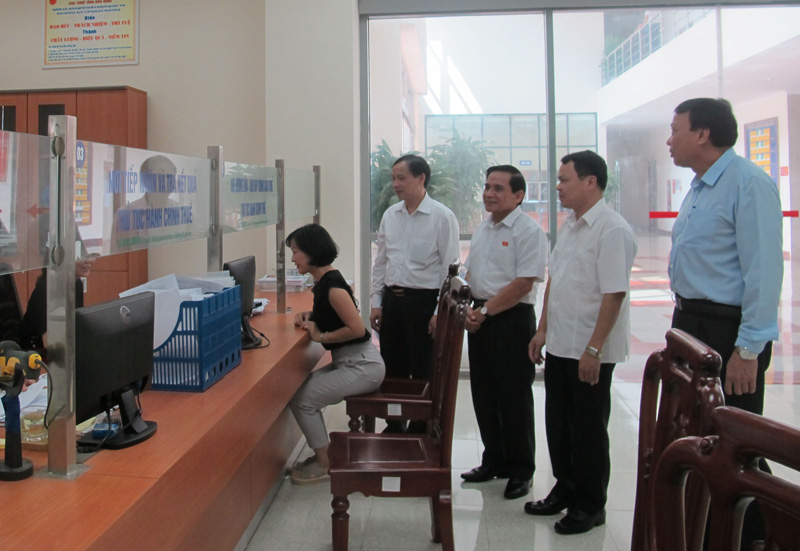
(HBO) – As tax is the main source of revenue for state and local budgets, authorities at all levels always give overriding priority to the prevention of tax revenue loss. This is a hard work that requires joint efforts.

Photo: Leaders of the People’s Committee and National Assembly
deputies of Hoa Binh inspect work of the one-door division at the province’s
taxation department.
Under
the direction of the Ministry of Finance, General Department of Taxation,
provincial Party Committee and People’s Committee, the province’s taxation
department has mapped out rational solutions to tax collection management and
tax loss prevention in parallel with popularising regulations on taxation and
supporting tax payers.
The province has renewed methods of popularisation like inviting newly
established businesses to tax agency to help them thoroughly grasp tax policies
and relevant administrative procedures. It has also joined hands with local
business associations to provide training on tax policies and accountancy
principles as well as organise conferences to honour standout tax payers. The "one-door”
mechanism has been maintained to instruct tax payers.
Inspection and settlement of violations have been paid due attention. From July
2013 to July 2017, the taxation agency gave punishment to 184 violating businesses.
Total collected tax arrears after inspections were 54.3 billion VND, reducing
125.2 billion VND in loss. As many 48.3 billion VND in tax and fine payment was
sent to the State budget.
Also in this period, the province’s taxation department examined 47,055 tax
declaration dossiers of 1,939 companies.
In 2017, the department inspected 43 business organisations and households and
gained total collected tax arrears and fine payment of 951 million NVD.
Thanks to the efforts to carry out tax policies and regulations, state budget
collection in the locality has seen significant improvements. In 2015, total
budget collection stood at 2.53 trillion VND, accounting for 112 percent of the
province’s set plan while the figures in 2016 and the first nine months of the
year were 3 trillion VND and 2.17 trillion VND, making up 104 percent and 72
percent of the local target./.
According to data from the Hoa Binh Provincial Party Committee, the industrial production index for the first six months of 2025 is estimated to have increased by 20% compared to the same period last year. This marks the highest year-on-year growth rate for this period since 2020.
In the first six months of 2025, Hoa Binh province’s export turnover was estimated at 1.145 billion USD, marking an 18.11% increase compared to the same period in 2024. Import turnover was estimated at $ 804 million, a 17.15% increase, which helped the province maintain a positive trade balance.
The lives of the ethnic minority farmers in Tan Lac district have gradually improved thanks to the new directions in agricultural production. This is a testament to the collective strength fostered through the professional associations and groups implemented by various levels of the district’s Farmers’ Union.
With the motto the "product quality comes first,” after nearly one year of establishment and operation, Muong village’s Clean Food Agricultural and Commercial Cooperative, located in Cau Hamlet, Hung Son Commune (Kim Boi district), has launched reputable, high-quality agricultural products to the market that are well-received by consumers. The products such as Muong village’s pork sausage, salt-cured chicken, and salt-cured pork hocks have gradually carved out a place in the market and they are on the path to obtaining the OCOP certification.
In the past, the phrase "bumper harvest, rock-bottom prices" was a familiar refrain for Vietnamese farmers engaged in fragmented, small-scale agriculture. But today, a new spirit is emerging across rural areas of Hoa Binh province - one of collaboration, organisation, and collective economic models that provide a stable foundation for production.
Maintaining growing area codes and packing facility codes in accordance with regulations is a mandatory requirement for agricultural products to be eligible for export. Recently, the Department of Agriculture and Environment of Hoa Binh province has intensified technical supervision of designated farming areas and packing facilities to safeguard the "green passport" that enables its products to access international markets.



